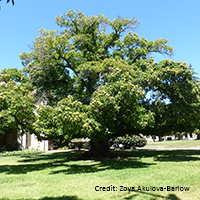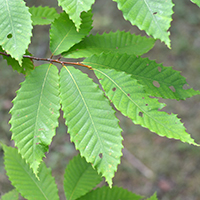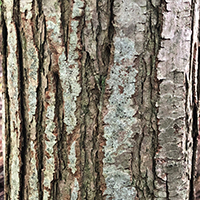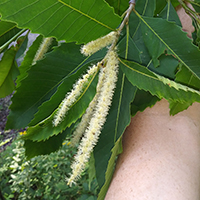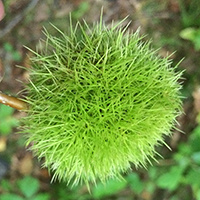What American chestnut looks like
Size and shape
- Medium-sized up to 10 metres high.
- Trunk up to 50 centimetres in diameter.
Leaves
- Yellowish green canoe-shaped leaves, often hook to the side.
- Long (15 to 28 centimetres) with distinct, forward-pointing teeth.
- Dark green on top and pale green on the bottom.
- Hairless on both sides.
Bark
- Smooth and dark brown when young.
- Becomes ridged and furrowed with age.
Flowers
- Long, pale green (almost white) catkins (12 to 20 centimetres).
- Bloom after the leaves are almost fully grown.
Fruit
- Large, round spiky husks enclose an edible brownish nut (5 to 8 centimetres).
- Chestnuts ripen in early fall.
Where American chestnut is found
American chestnut is a Carolinian species that is at risk in Ontario. It is found in Southern Ontario, west of Toronto through London and south to Windsor.
Find out what we are doing to protect American chestnut by reading the recovery strategy.
What you need to know to grow American chestnut
- Moisture: grows best in moist to dry, well-drained soil.
- Soil: tolerates many soil types, even rocky sites.
- Shade: tolerates full sun to full shade.
- Caution:
- chestnut blight is a fungus that has decimated American chestnut populations. The fungus attacks twigs, branches and the trunk of the tree leading to cankers that eventually kill the tree.
Benefits and uses of American chestnut
Wildlife benefits
American chestnut provide food for many species. Birds and large mammals eat the nuts. Moths and caterpillars eat the leaves.
Commercial uses
American chestnut wood is straight-grained and rot-resistant and was once widely used for everything from furniture to railroad ties. The trees were historically harvested for their tannins for the leather industry. The nuts were formerly eaten by people and fed to cattle.
Fun facts about American chestnut
- American chestnuts were an important food and lumber source until chestnut blight devasted the population in the 1900s.
- American chestnut is now often only found as stump sprouts, less than 6 metres tall.
- In 1988, the Canadian Chestnut Council began locating surviving trees and developing a breeding program to increase resistance to disease and population numbers.
Updated: January 10, 2024
Published: October 21, 2014
